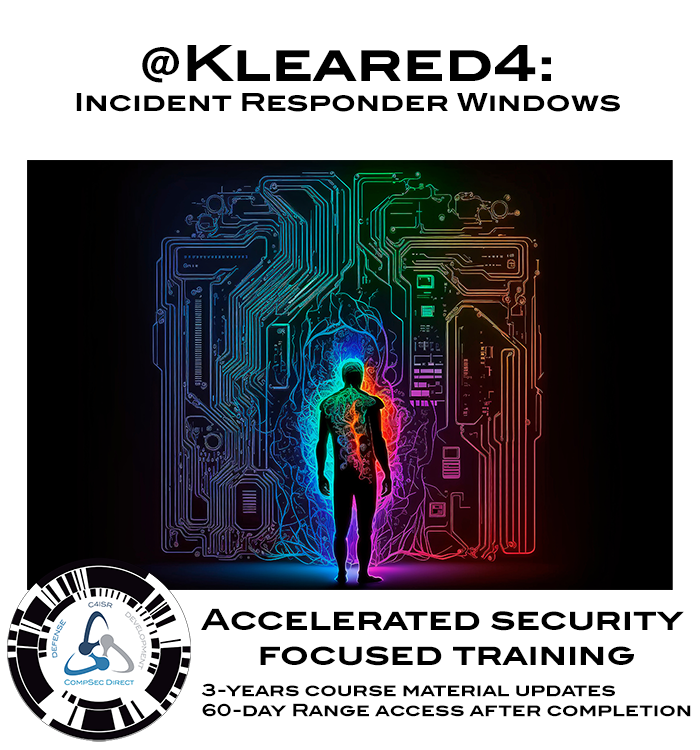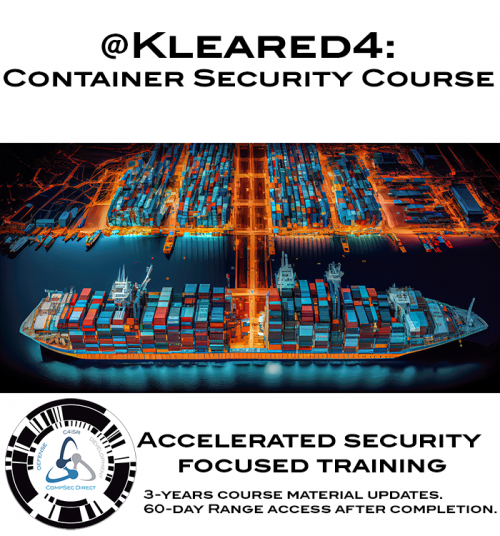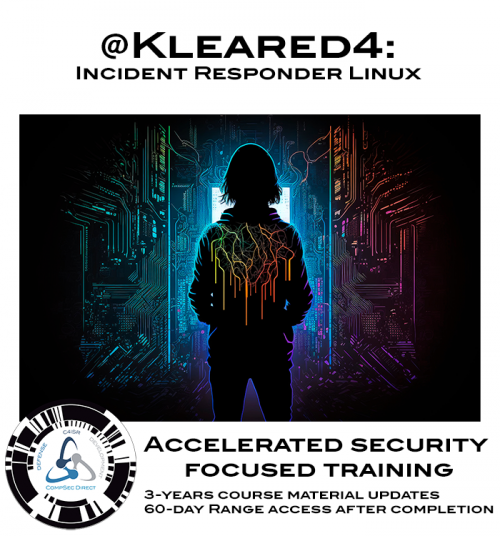Description
This course covers basic and advanced actions a Windows focused responder must perform to reduce the overall impact and costs of incidents.
Learning Objectives
Participants of this course will learn how-to:
- Responding to unexpected outages
- Responding to acts of sabotage
- Responding to malicious insiders
- Responding to ransomware
- Media acquisition, disk imaging and memory captures
- Out of band communication techniques
- Coordination and mitigations strategies
- Tactical decision-making
- Modern incident response tools and applications usage for FY 2026
Overall Proficiency Level: 2 – Intermediate
Course Catalog Number: K4IRW
Course Prerequisites:
- Familiarity with incident response tools and applications
- Familiarity with the Windows operating system
- Modern operating system with web-browser
- Stable internet connectivity
- Microsoft Teams account (free accounts available)
Training Purpose: Functional Development, Incident Response
Delivery Method: Online, Instructor-Led, Remote
Course Length: 2 Days
Languages: English or Spanish options for instruction. Please select correct date and language for course instruction.
Benefits: 3-years course material updates. 60 day access to Kleared4 after course completion.
Standard support over business hours EST/EDT 0800-1700 8am-5pm
Government PO accepted.
10% discounts available for groups of 10 participants or more.
16 hours of instruction with continuing education certificate upon complete attendance
Course Syllabus
Day 1: Introduction, Triage, and Initial Response (8 Hours)
Module 1: Incident Response Fundamentals on Windows (1.5 Hours)
This module lays the groundwork by reviewing core incident response principles and how they apply to Windows systems. Students learn the NIST incident response lifecycle and the unique challenges of Windows environments. We discuss preparation steps such as building an incident response kit with essential open-source tools and establishing communication plans. Key best practices: including maintaining alternate communication channels in case primary networks are compromised. Participants also review real-world Windows threat trends to understand the importance of being ready for a broad range of incidents.
- Incident Response Process: Overview of the major IR phases and how a Windows responder navigates them.
- Communication & Coordination: Developing an incident communication plan with primary and backup methods. Importance of out-of-band communications to coordinate response without using potentially compromised channels. Defining roles for efficient team operations.
- Windows-specific Considerations: Differences in Windows vs. Linux incidents including logging mechanisms, default security controls, typical attack vectors on Windows servers. Common Windows attack scenarios in recent years and why swift response is crucial.
- Preparation and Tools: Guidance on assembling a responder kit for Windows incidents. We cover open-source tools that should be on hand, including live response scripts, memory capture tools, disk imaging tools, hashing utilities, and documentation templates. Students see examples of kit contents.
- Lab: Windows IR Orientation and Setup – Students set up their lab environment and toolkits. This lab reinforces the preparation steps before an incident hits.
Module 2: Forensic Data Collection – Disk Imaging and Memory Capture (2 Hours)
In this module, participants learn how to collect critical forensic evidence from Windows systems in a safe, forensically sound manner. We cover media acquisition techniques for both disk and RAM, which are fundamental initial actions in many incidents. Students will use classic Unix tools as well as modern utilities to create exact byte-for-byte images of disks and to snapshot volatile memory content while preserving evidence integrity.
- Disk Imaging Fundamentals: The importance of capturing an exact image vs a disk copy of affected drives before making changes. Introduction to create raw disk images. We also introduce why some open-source tools no longer work. Best practices such as hashing the image (SHA-256) to verify integrity and using write blockers are explained.
- Memory Acquisition on Windows: Discussion of why RAM snapshots are crucial – memory may contain running malware, encryption keys, network connections, and other evidence that disappears on shutdown. Students learn to use live memory capture on Windows. We also cover dumping Windows memory. Techniques for triggering minimal system disruption during capture are discussed.
- Evidence Preservation: Ensuring chain-of-custody and integrity during collection. This includes capturing relevant system time info, carefully labeling collected images, and storing originals securely. The module highlights avoiding common mistakes like forgetting to collect critical logs or volatile data in the rush to remediate. Students also learn decision points, and how to prioritize what to collect first.
- Initial Triage Data: Beyond full disk/memory images, we mention quick triage collection using our open-source survey scripts. Introducing the concept of a “live response” script that can gather key host artifact data.
- Lab: Disk and Memory Acquisition on a Windows VM – Students perform a forensic disk image and a memory dump on a provided Windows virtual machine. The lab guides them through verifying that the memory dump was successful and discusses where the files would be stored for analysis. This exercise builds confidence in using open-source imaging tools and handling output safely.
Module 3: Responding to Unexpected Outages (2 Hours)
This scenario-based module addresses how to respond when a Windows server or service experiences an unexpected outage or downtime. System outages can stem from accidents or malicious actions. Participants will learn to treat outages with an investigative approach. The module walks through an outage response playbook: triage, evidence gathering, service restoration, and root cause analysis to distinguish benign causes from attacks.
- Detection of an Outage: Recognizing signs of outages vs. security incidents. Discussion of monitoring and alerts that might report a server down, and initial steps the sysadmin/responder should take. Emphasis on checking whether multiple systems are affected or a single host.
- Initial Triage Checks: Students learn a systematic approach to investigate an outage on a Windows server: reviewing system logs for errors or panic messages, verifying if there were recent configuration changes or patches applied, and observing any unusual logins or user activity prior to the outage.
- Distinguishing Cause: Techniques for differentiating a simple failure from malicious activity. The module covers looking for artifacts of sabotage even in an outage.
- Response Actions: Once immediate cause is hypothesized, we explain how to proceed.
- Communication During Outages: Tips on informing stakeholders and users about an outage.
- Lab: Outage Investigation Drill – Students are given a simulated Windows server outage scenario. They receive log excerpts and system status outputs from the time of the incident. The task is to analyze these artifacts to figure out what happened: for example, logs might show a sudden reboot and an odd user login before it. Students must determine if the outage was likely due to a system crash or a malicious reboot, and answer guided questions. This lab builds skill in quick log analysis and critical thinking during an outage.
Module 4: Responding to Acts of Sabotage (2 Hours)
In this module, participants tackle incidents of sabotage; deliberate attempts to damage, disrupt, or destroy systems or data. The module covers how to recognize sabotage, contain its effects, gather evidence on what was done, and remediate the damage. Real examples are discussed to illustrate the stakes.
- Identifying Sabotage: Signs that an incident is intentional sabotage rather than a glitch.
- Immediate Containment: Students learn to isolate affected machines or networks to stop the destructive action. We also discuss preserving any volatile evidence.
- Investigation and Evidence: Techniques to investigate what happened during a sabotage incident.
- Mitigation & Recovery: Strategies to mitigate the impact of deliberate sabotage involving law enforcement and doing a thorough post-incident review for legal evidence.
- Case Study: A brief case study is presented that discusses how the incident was identified and resolved, reinforcing lessons.
- Lab: Sabotage Incident Analysis – In this lab, students examine a simulated sabotage scenario. This lab hones skills in forensic analysis of a destroyed system and reinforces the value of quick containment and good backups.
Day 2: Advanced Threats, Tools, and Response Strategies (8 Hours)
Module 5: Responding to Malicious Insider Threats (2 Hours)
This module focuses on malicious insiders, or authorized users who abuse their access for malicious purposes such as data theft, espionage, or sabotage. Participants learn how to detect indicators of insider misuse on Windows systems and the appropriate response actions.
- Indicators of Insider Abuse: We discuss common red flags that may suggest an insider is acting maliciously.
- Log and Audit Analysis: The module teaches how to leverage Windows’s logging to investigate an insider. Students learn to aggregate and search logs for suspicious patterns.
- Stealth and Out-of-Band Considerations: The module stresses using out-of-band communications internally. This touches on tactical decision-making: whether to observe longer or cut off access quickly.
- Containment and Eradication for Insiders: Steps to contain a malicious insider. We discuss the need for a thorough scan of any rogue artifacts the insider may have planted.
- Legal and HR Aspects: Discussion on handling insider incidents regarding evidence collection and whether to prosecute or not. The importance of chain-of-custody and other legal considerations including privacy protection.
- Lab: Insider Threat Hunt on Windows – Students are given access to logs and data from a scenario where an insider is exfiltrating data. They will then execute containment steps and how they preserve evidence. This lab builds competence in analyzing various Windows logs for malicious patterns.
Module 6: Responding to Ransomware Incidents (2 Hours)
In this module, participants learn a structured approach to handling a ransomware incident on Windows. We reference best-practice checklists from CISA and adapt them to Windows environments.
- Detection and Impact Assessment: How to recognize that a Windows system is hit by ransomware.
- Immediate Containment Actions: Students learn coordination of drastic action involving management approval and user communication.
- Power State and Memory Considerations: Students practice judgment calls or trade-offs during ransomware incidents.
- Forensic Capture and Analysis: We introduce tools for analyzing Windows ransomware behavior, including knowing whether the ransomware had data exfiltration capability as part of analysis.
- Eradication and Recovery: Strategies for removing ransomware and restoring services. We discuss verifying backups before restoration. Responders should find the root cause during recovery to avoid immediate reinfection.
- Coordination and Communication: We outline an incident communication plan specific to ransomware.
- Lab: Ransomware Containment Exercise – This lab is a time-sensitive simulation. Students connect to a sandboxed Windows environment where live ransomware is running. They must identify the process, isolate the machine as they practice restoring the affected files from a provided backup.
Module 7: Open-Source Incident Response Tools & Techniques (4.0 Hours)
This module provides a survey of modern open-source tools that can greatly aid incident response in Windows environments. The goal is to familiarize participants with the capabilities of these tools and how they fit into an IR. All tools covered are free and open-source, aligning with our no-commercial-tools approach.
- Host Intrusion Detection: Students learn how such tools can be deployed beforehand to provide valuable alerts during an incident.
- Enterprise DFIR Platforms: Coverage of tools for enterprise-scale incident response on many machines. Participants see how such tools are useful for threat hunting and responding to widespread.
- Threat Intelligence and SIEM (brief): How to integrate open-source IR with broader detection.
- Collaboration and Case Management: Introduction open-source incident response platforms for case tracking, and how analysts document and share findings during an incident.
- Lab/Demo: Tool Showcase Lab – This is a guided demonstration and student exploration of select tools. This lab solidifies the understanding of what each tool can do and encourages students to continue exploring these powerful open-source IR tools beyond the course.





